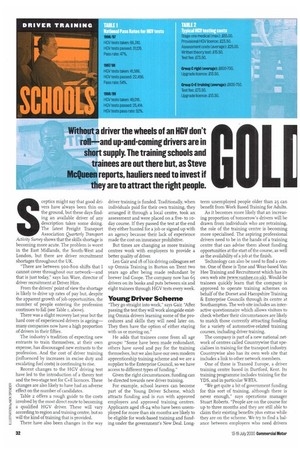Without a driver the wheels of an HGV don't roll—and
Page 34

Page 35

If you've noticed an error in this article please click here to report it so we can fix it.
up-and-coming drivers are in short supply. The training schools and trainees are out there hut, as Steve McQueen reports, hauliers need to invest if they are to attract the right people.
Sceptics might say that good drivers have always been thin on the ground, but these days finding an available driver of any description takes some doing. The latest Freight Transport Association Quarterly Transport Activity Survey shows that the skills shortage is becoming more acute. The problem is worst in the East Midlands, the South-West and London, but there are driver recruitment shortages throughout the UK.
"There are between 500-800 shifts that I cannot cover throughout our network—and that is just today," says Ian Ware, director of driver recruitment at Driver Hire.
From the drivers' point of view the shortage is likely to drive up rates of pay but, despite the apparent growth of job opportunities, the number of people entering the profession continues to fall (see Table I, above).
There was a slight recovery last year but the hard core of experienced drivers is ageing— many companies now have a high proportion of drivers in their fifties.
The industry's tradition of expecting new entrants to train themselves, at their own expense, has discouraged new entrants to the profession. And the cost of driver training (influenced by increases in excise duty and escalating fuel costs) is continuing to rise.
Recent changes to the HGV driving test have led to the introduction of a theory test and the two-stage test for C+E licences. These changes are also likely to have had an adverse effect on the number of candidates.
Table 2 offers a rough guide to the costs involved by the most direct route to becoming a qualified HGV driver. These will vary according to region and training centre, but so will the kind of training that is provided.
There have also been changes in the way driver training is funded. Traditionally, when individuals paid for their own training, they arranged it through a local centre, took an assessment and were placed on a fiveto roday course. If they passed the test at the end they either hunted for a job or signed up with an agency because their lack of experience made the cost on insurance prohibitive.
But times are changing as more training centres work with employers to provide a better quality of driver.
Len Gair and TS of his driving colleagues set up Omnia Training in Burton on Trent two years ago after being made redundant by brewer Ind Coope. The company now has 65 drivers on its books and puts between six and eight trainees through HGV tests every week,
Young Driver Scheme
"They go straight into work," says Gair. "After passing the test they will work alongside existing Omnia drivers learning some of the procedures and skills they will need later on. They then have the option of either staying with us or moving on."
He adds that trainees come from all age groups: "Some have been made redundant, others have saved and pay for the training themselves, but we also have our own modem apprenticeship training scheme and we are a supplier to the Enterprise Council, so we have access to different types of funding."
Given the right circumstances, funding can be directed towards new driver training.
For example, school leavers can become part of the Young Driver Scheme, which attracts funding and is run with approved employers and approved training centres. Applicants aged 18-24 who have been unemployed for more than six months are likely to be eligible for work-based training and funding under the government's New Deal. Long
term unemployed people older than 25 can benefit from Work Based Training for Adults.
As it becomes more likely that an increasing proportion of tomorrow's drivers will be drawn from individuals who are retraining, the role of the training centre is becoming more specialised. The aspiring professional drivers need to be in the hands of a training centre that can advise them about funding opportunities at the start of the course, as well as the availability of a job at the finish.
Technology can also be used to find a centre. One of these is Tyne and Wear-based Van Hee Training and Recruitment which has its own web site (www.vanhee.co.uk). Would-be trainees quickly learn that the company is approved to operate training schemes on behalf of the Dorset and Hampshire Training & Enterprise Councils through its centre at Southampton. The web site includes an interactive questionnaire which allows visitors to check whether their circumstances are likely to match those currently attracting funding for a variety of automotive-related training courses, including driver training.
The company is part of a new national network of centres called Countrywise that specialises in training for the transport industry. Countrywise also has its own web site that includes a link to other network members.
One of these is Transed Europe, a driver training centre based in Dartford, Kent. Its training programme includes training for the YDS, and in particular WBTA.
"We get quite a bit of government funding for this sort of training, although there is never enough," says operations manager Stuart Roberts. "People are on the course for up to three months and they are still able to claim their existing benefits plus extras while they are on the scheme. We try to find a balance between employers who need drivers and the trainees who need the experience and the training credits to help them to get a job at the end of it."
Roberts says it is becoming easier to find work for newly qi ialified drivers because many fleet operators are now doing their own driver assessments. "For a long time insurance companies have been telling operators that they can't employ anyone with less than two years' experience," he adds. "Companies are now saying to insurers that if our assessor says the driver is fully qualified and can pass the assessment, even if the driver has had very little experience, we want you to insure them!"
This seems to be further evidence of the
success of the practices of training providers such as Omnia.
It is not clear whether the more direct route from trainee to full-time driver is responsible for the rise in driver insurance rates, but rise they have.
Peter Glasspool, joint principal at Northumberland-based Cramlington Insurance Services, which specialises in vehicle insurance for owner-drivers and small fleets, reports that insurance has been loaded by up to 50% in the past year. He warns that several major insurers have now stopped quoting on new fleet insurance, citing losses on high accident claims.
Carry on learning
Passing the HGV driving test does not make a trainee a skilled driver; the licence simply allows new drivers to carry on learning in a working environment. Better skills come with experience and further training, but unfortunately once the driver has his licence the funding stops, and so does the industry's willingness to invest.
"Everybody pays lip service to training but nobody wants to pay," says Driver Hire's Ian Ware. His company supports the City & Guilds Driver Training Scheme, which seeks to "upskill" qualified drivers. "As far as skills training for drivers is concerned there is absolutely no funding whatsoever, either coming from Europe or central government," he adds.
Ware believes that the driver shortage will become worse because of increased freight movements and the expansion in e-commerce. This will also bring a need for the extra skills demanded in the home delivery sector.
One thing is clear: the industry is going to need more skills from a smaller number of drivers. And sooner or later, somebody will have to pay for it.




































































































